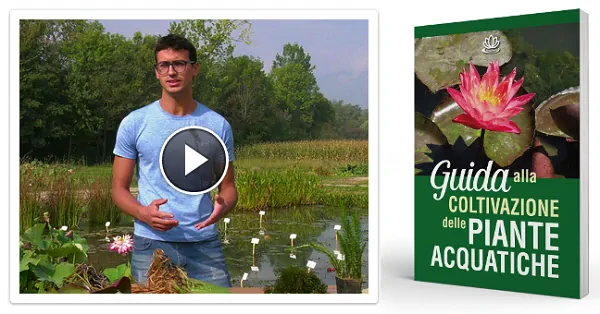Sistemas de fitodepuración
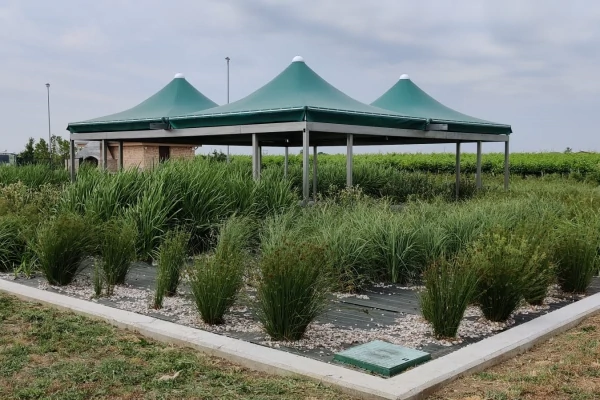
Los sistemas de fitopurificación permiten la purificación natural del agua.
La fitopurificación es una técnica de purificación del agua basada en el uso de plantas acuáticas.
Este proceso ocurre de manera natural en los estanques, gracias a las plantas acuáticas y las bacterias que viven simbióticamente en sus raíces.
El mismo mecanismo se utiliza para purificar el agua en piscinas ecológicas, estanques de carpas koi y verdaderos sistemas de fitopurificación para aguas residuales civiles e industriales.
La purificación tanto de aguas residuales civiles como industriales con fitopurificación tiene como producto final un agua libre de contaminantes y elementos patógenos (virus y bacterias).
Los sistemas de fitopurificación se basan en la acción combinada de:
- Plantas acuáticas
- Bacterias que viven en el sustrato alrededor de los rizomas de las plantas acuáticas
- Y aguas residuales que se van a tratar.
Las plantas acuáticas tienen la función de crear un hábitat adecuado para el crecimiento de la flora bacteriana.
En la práctica, las plantas acuáticas capturan oxígeno de la atmósfera y lo transportan desde las hojas, pasando por el tallo, hasta las raíces (o rizomas) de la planta y luego al rizosfera (la capa de tierra donde se encuentran los rizomas de la planta), haciéndolo disponible para las bacterias aeróbicas presentes en el sustrato.
Estas bacterias, que viven en simbiosis con las plantas, necesitan oxígeno para vivir y desempeñar su función.
Su función es degradar los contaminantes y las sustancias orgánicas, transformándolos en sustancias inorgánicas disponibles para las plantas.
Además, las plantas también contribuyen a la depuración absorbiendo como nutrientes para su crecimiento una parte de las sustancias disueltas en el agua y transformadas por las bacterias.
Las plantas también tienen la función de proporcionar sombra en la superficie del estanque y, por lo tanto, regular la temperatura del efluente (una temperatura demasiado alta puede reducir las funciones vitales de las bacterias).
Las zonas del sistema de fitodepuración que no reciben oxígeno albergan bacterias anaeróbicas, que también contribuyen al proceso de depuración.
Un sistema de fitodepuración es capaz de cumplir su función unos pocos meses después de su inicio, especialmente si se plantan las plantas acuáticas en primavera.
Las especies de plantas acuáticas a utilizar varían según el tipo de sistema de fitodepuración que se quiera crear.
Para obtener más información sobre los conceptos relacionados con la fitodepuración y el hábitat acuático equilibrado, descarga gratis la «Guía para el Cultivo de Plantas Acuáticas«.
Tipos de sistemas de fitodepuración
Los sistemas de fitopurificación se clasifican según las características del tanque y el recorrido que siguen los efluentes dentro del tanque:
- Fitodepuración de flujo superficial o libre,
- Fitodepuración flotante,
- Fitodepuración de flujo sumergido horizontal,
- Fitodepuración de flujo sumergido vertical,
- Sistemas híbridos.
Fitodepuración de flujo superficial o libre
Este tipo de sistema es el más sencillo, ya que consiste en un estanque poco profundo impermeable, similar a un estanque tradicional. En el fondo del estanque se coloca un sustrato en el que se plantan las plantas acuáticas.
Las plantas utilizadas pueden ser:
- Plantas palustres (como Pontederia cordata, Sparganium erectum, Iris pseudacorus, Schoenoplectus lacustris, Glyceria maxima Variegata, Butomus umbellatus),
- Nenúfares y nuphar,
- Plantas oxigenantes sumergidas (como Ceratophyllum demersum, Myriophyllum spicatum, Elodea canadensis).
Este tipo de sistema, en comparación con los sistemas de flujo sumergido, requiere una mayor superficie para una capacidad de depuración equivalente.
Este sistema se utiliza solo para tratar aguas poco contaminadas (por ejemplo, como un estanque secundario para carpas koi o como parte de una biopiscina) o como tratamiento final aguas abajo de un sistema de flujo sumergido.
Si se utiliza este sistema para la fitodepuración de aguas muy contaminadas, puede haber problemas de malos olores y se pueden formar muchas algas en la superficie. Por lo tanto, por ejemplo, para aguas procedentes de alcantarillas o instalaciones ganaderas, se utiliza solo el sistema de flujo sumergido.
En esta imagen se puede ver un diagrama de un sistema de fitopurificación de superficie libre de agua. (Fuente: ISPRA, 2012)
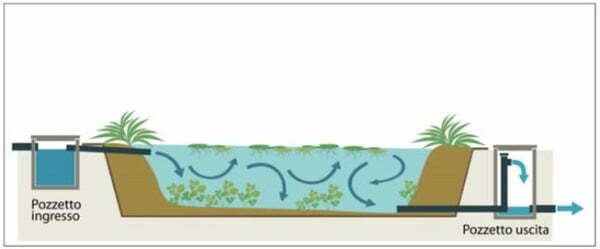
Fitodepuración flotante
Entre los sistemas de fitodepuración de flujo superficial, el sistema de fitodepuración flotante está ganando cada vez más popularidad, y consiste en utilizar soportes flotantes (una especie de balsas) en los que se plantan plantas palustres (particularmente eficaces en la fitodepuración) que de otro modo no podrían flotar.
Este sistema es especialmente útil para depurar aguas de canales o ríos, donde no es posible enraizar las plantas en el fondo.
Para crear un sistema de fitodepuración flotante, se debe crear una barrera flotante transversal al flujo de agua, instalada de una orilla a la otra, utilizando una balsa hecha de forma casera o con los módulos patentados Tech-IA.
Un elemento Tech-IA tiene forma rectangular y pesa aproximadamente 2 kg. Tiene una alta resistencia mecánica, alta resistencia a agentes químicos, biológicos y climáticos, y puede soportar una carga de hasta 20 kg. Cada elemento tiene ocho rejillas adecuadas para albergar las plantas para la fitodepuración y seis orificios para anclarlos a otros elementos y a las orillas para la anclaje estático.
La barrera flotante se ancla en la orilla con cuerdas y estacas, o en el fondo del estanque con pesos muertos, dejando suficiente cuerda para facilitar las fluctuaciones del nivel de agua durante períodos de lluvias intensas.
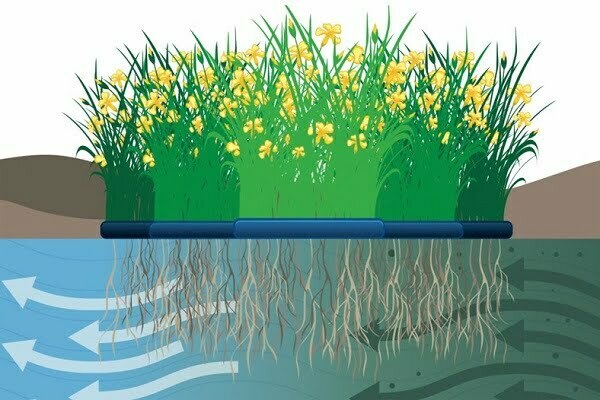
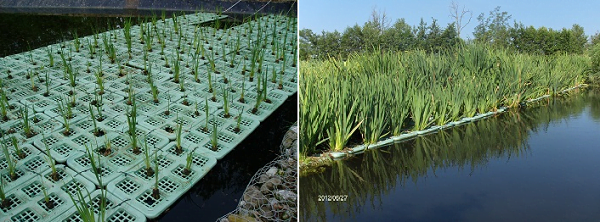
Las plantas palustres que se utilizan en el sistema de fitodepuración flotante pueden ser, por ejemplo, Iris pseudacorus, Glyceria maxima Variegata, Carex pseudocyperus, Carex riparia, Juncus effusus.
Las raíces de las plantas pueden descender hasta un metro en el agua debajo de los módulos flotantes, creando así un filtro biológico para el control de la contaminación.
Además, este sistema también representa un hábitat interesante para peces y aves acuáticas que pueden encontrar refugio entre las plantas.
Fitodepuración de flujo sumergido horizontal
La fitodepuración con sistema de flujo sumergido horizontal consta de un estanque impermeable lleno en el fondo con una capa de grava por la que el efluente fluye en sentido horizontal.
De esta manera, los líquidos no entran en contacto con el aire y se evita el problema de los malos olores.
Las plantas se plantan sobre la capa de grava por donde fluye el efluente, y las raíces crecen dentro de la grava, creando zonas de depuración aeróbica intercaladas con zonas de depuración anaeróbica.
En este tipo de instalación, se utilizan plantas palustres como Phragmites australis, Iris pseudacorus, Glyceria maxima Variegata, Carex pseudocyperus, Carex riparia, Juncus effusus y Cyperus longus.
Este tipo de instalación se utiliza para el tratamiento de aguas residuales civiles e industriales y para el tratamiento de efluentes agrícolas.
A continuación, se presentan los resultados de los análisis realizados en una instalación experimental de fitodepuración de flujo sumergido horizontal en funcionamiento desde 1996 en Lugo di Baiso (Italia). Las plantas utilizadas son Phragmites Australis.
- Eficiencia de eliminación de sustancias orgánicas de desecho (DBO): 90% (60/70% en invierno),
- Eficiencia de eliminación de sólidos suspendidos totales: 90%,
- Eficiencia de eliminación de bacterias: 90/99%,
- Eficiencia de eliminación de nitrógeno y fósforo: hasta el 90%.
En esta imagen, puedes ver un esquema de la instalación de fitodepuración de flujo sumergido horizontal. (Fuente: ISPRA, 2012)
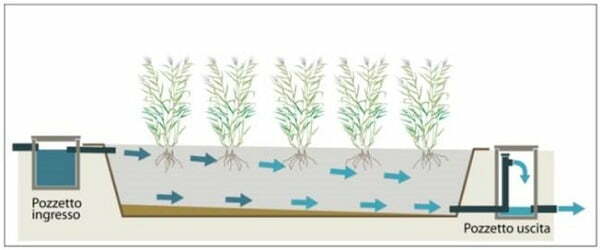
Fitodepuración de flujo sumergido vertical
El sistema de fitodepuración de flujo sumergido vertical consiste siempre en un estanque impermeable en el que las plantas se colocan sobre una capa de grava, pero el efluente se hace filtrar desde arriba de manera intermitente mediante una bomba.
Este sistema tiene la ventaja de facilitar la difusión de oxígeno dentro del sustrato.
Con cada llenado, de hecho, el sustrato atrapa el aire incluso en las profundidades, formando colonias de bacterias aeróbicas incluso en las partes más profundas y poco colonizadas por las raíces.
En este tipo de instalación se utilizan plantas palustres como Phragmites australis, Iris pseudacorus, Glyceria maxima Variegata, Carex pseudocyperus, Carex riparia, Juncus effusus y Cyperus longus.
Este tipo de instalación también se utiliza para el tratamiento de aguas residuales civiles e industriales y para el tratamiento de efluentes agrícolas.
En un sistema de fitodepuración de flujo vertical de aguas mixtas realizado en el municipio de Gorizia (Italia), en funcionamiento desde 1995, se registraron los siguientes valores:
- Eficiencia de eliminación de sustancias orgánicas de desecho (DBO): 90% y DQO 65%,
- Eficiencia de eliminación de amonio: 60%,
- Eficiencia de eliminación de nitrógeno total: 75%,
- Eficiencia de eliminación de fosfato: 90%,
- Eficiencia de eliminación de coliformes totales y fecales: > 99%.
En esta imagen, puedes ver un esquema del sistema de fitodepuración de flujo sumergido vertical. (Fuente: ISPRA, 2012)
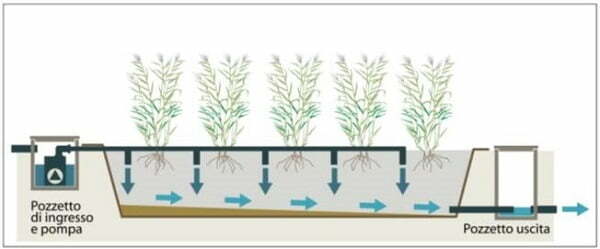
Sistemas de fitodepuración híbridos
Las diferentes tipologías de sistemas de fitodepuración pueden combinarse con el objetivo de optimizar la eficiencia en la depuración de ciertos tipos de efluentes en el ámbito industrial o agrícola.
Por ejemplo, es posible crear varias piscinas de fitodepuración sumergida en cascada y luego, aguas abajo, una piscina de flujo superficial (como un estanque).
Áreas de aplicación de la fitodepuración
Con los sistemas de fitodepuración, es posible depurar:
- Estanques ornamentales con peces (como carpas koi), tortugas o patos.
- Biopiscinas o lagos aptos para el baño.
- Efluentes agrícolas agroalimentarios.
- Efluentes agrícolas de viticultura y vinicultura.
- Efluentes agrícolas contaminados con pesticidas.
- Efluentes de establos, perreras o granjas.
- Efluentes de viviendas civiles, desde viviendas unifamiliares hasta edificios enteros.
- Efluentes de agroturismos y campings.
- Efluentes industriales.
- Efluentes de bodegas y queserías.
- Lixiviados de minas y vertederos.
- Desviaciones de cursos de agua eutróficos.
En ausencia de alcantarillado público, las aguas residuales domésticas pueden ser tratadas mediante un sistema de fitodepuración. Por supuesto, los desechos líquidos deben ser separados aguas arriba mediante un pozo IMHOFF o una fosa séptica.
Ventajas de la fitodepuración
Entre las ventajas del uso de la fitodepuración se encuentran:
- Costos reducidos de instalación.
- Ausencia de consumo de energía.
- Gestión y mantenimiento reducidos, realizables incluso por personal no especializado.
- Ahorro de kilómetros de tubería para la conexión a las alcantarillas.
- Posibilidad de reutilizar el agua tratada donde no se requiere agua potable (cisterna del inodoro, riego, etc.).
- Ahorro de energía eléctrica en comparación con los sistemas de depuración convencionales.
- Larga durabilidad.
Uso de los sistemas de fitodepuración en la actualidad
En la actualidad, en Europa hay decenas de miles de sistemas de fitodepuración en funcionamiento, la mayoría de los cuales se encuentran en países del norte, donde se utilizan desde hace muchos años para reducir la contaminación proveniente de pequeñas y medianas fuentes de contaminación.
En Europa e Italia, los sistemas de flujo superficial y vertical sumergido son los más comunes (más del 75%), utilizados principalmente para el tratamiento secundario de aguas residuales domésticas y civiles.
Los sistemas de flujo superficial son los más utilizados en nuestras áreas por las siguientes razones:
- Fácil integración en entornos urbanos y/o periurbanos.
- Alta eficiencia de depuración incluso en los meses de invierno.
- Mayor simplicidad en la gestión y el mantenimiento.
- Ausencia de problemas relacionados con olores desagradables y la presencia de insectos.
- Mejor relación entre la superficie requerida y la eficiencia del tratamiento.
El uso de sistemas de fitodepuración para el tratamiento de aguas residuales ha experimentado un aumento significativo en los últimos años, y somos aún más optimistas para el futuro.
Si deseas instalar un sistema de fitodepuración, podemos proporcionarte láminas impermeabilizantes y las plantas más adecuadas para tu caso específico.
¡Contáctanos a través de los canales indicados en la página de Contacto!

Con la compra de al menos 100€, puedes acceder a Plantas Acuáticas Gold Exclusive y tienes derecho a:
- Envío gratuito (en la mayoría de los países europeos o con descuentos en otros países);
- Servicio de asistencia de 12 meses;
- Posibilidad de activar la Garantía de crecimiento de las plantas 100% (en nenúfares, flores de loto y plantas palustres, recomendadas por nosotros mediante los Kits de Estaque Fácil o la Consulta de Estanques, o escogidas cuidadosamente leyendo las hojas de información de la planta en la página web y que son plantadas de acuerdo con los manuales impresos, incluyendo el envío);
- Vídeos detallados de como cultivar plantas acuáticas;
- Manuales prácticos impresos de cómo plantar las plantas acuáticas correctamente para resolver todas tus dudas.
¿Tienes preguntas sobre la gestión de pedidos y envíos?
Descubre todas las respuestas a las preguntas frecuentes sobre el envío de plantas, la gestión de pedidos y consejos de compra.

¿Quieres asegurarte de colocar las plantas más adecuadas para tu estanque y con garantía de crecimiento?
¡Descubre más sobre nuestros servicios!

Las plantas más apropiadas para tu estanque seleccionadas por nuestro personal para garantizar una estética óptima y una fitodepuración efectiva

El diseño personalizado de tu estanque con la disposición gráfica de las plantas más adecuadas

Te seleccionamos las plantas adecuadas para tu piscina ecológica en las cantidades más apropiadas según la superficie
Descubre cómo configurar tu estanque con las plantas acuáticas adecuadas para crear un entorno magnífico y en perfecto equilibrio
Accede al Video Curso y descarga la "Guía para el Cultivo de Plantas Acuáticas" (¡Gratis!)
COMIENZA AHORAQué dicen nuestros clientes sobre nosotros
